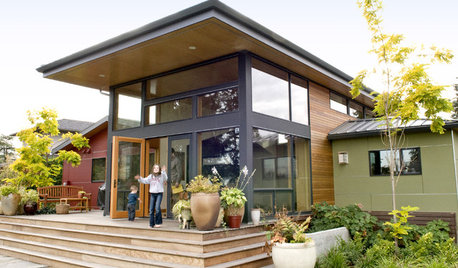The more sobering aspects of bamboo
bobnorth
18 years ago
Related Stories

GREEN DECORATINGBamboo Products — Earth Friend or Foe?
The ecofriendliness of this grass for flooring, wall coverings and furniture isn't cut and dried. Get the facts here
Full Story
MATERIALSBamboo Sprouts Up in Bountiful Home Uses
When utensils, flooring and even fabric can be made from a single renewable material, it's a design winner
Full Story
COLORMore Top Paint Picks for 2014: New Greens, Blues and Neutrals
Valspar’s new colors aim to lift spirits and express creativity. Here’s how to use 9 of them in lively ways
Full Story
BEFORE AND AFTERSHouzz Tour: A San Diego Townhouse Gets a Bright Update
Savvy shopping and warm bamboo accents help California architects give their home a fresh, high-end feel
Full Story
GARDENING AND LANDSCAPINGChoosing a Deck: Plastic or Wood?
Get the pros and cons of wood, plastic, composite and more decking materials, plus a basic price comparison
Full Story
SELLING YOUR HOUSE10 Ways to Boost Your Home's Resale Value
Figure out which renovations will pay off, and you'll have more money in your pocket when that 'Sold' sign is hung
Full Story
REMODELING GUIDESDesign Workshop: Is an In-Law Unit Right for Your Property?
ADUs can alleviate suburban sprawl, add rental income for homeowners, create affordable housing and much more
Full Story
REMODELING GUIDESYour Floors: Zebra, Tiger, and Teak Wood, Oh, My!
Get the Pros and Cons of Exotic Woods: Hickory, Cherry, Rosewood and More
Full Story
LANDSCAPE DESIGNGardening for Happy Kids
Foster creativity, self-esteem and more by designing your landscape with a sense of discovery
Full Story
DECORATING GUIDESHow to Make Wood Tones Work for You
Avoid the ski lodge look by using the rule of three, creating texture, adding pattern and more to expertly mix wood types
Full Story





hello_c_j_here
kentuck_8b
Related Professionals
Matthews Landscape Contractors · El Reno Landscape Contractors · Hurricane Landscape Contractors · Maywood Landscape Contractors · Pomona Landscape Contractors · Seven Hills Landscape Contractors · Waltham Landscape Contractors · Holliston Carpenters · Mountain View General Contractors · Murrysville General Contractors · Park Forest General Contractors · Rossmoor General Contractors · Stoughton General Contractors · Waldorf General Contractors · Woodmere General Contractorshello_c_j_here
kentuck_8b
rfgpitt
kentuck_8b
koniferkid_nj
kudzu9
cactusjoe1
lkz5ia
hollenback
tcstoehr
rfgpitt
kudzu9
rfgpitt
kudzu9
meat
kudzu9
koniferkid_nj
strangelove
strangelove
rfgpitt
Cady
Thuja
koniferkid_nj
Thuja
Cady
lkz5ia
bobnorthOriginal Author
koniferkid_nj
kudzu9
strangelove
rfgpitt
foxd
kudzu9
rfgpitt
koniferkid_nj
kudzu9
foxd
genecolin
gene_in_lugoff
koniferkid_nj
gene_in_lugoff
Cady
koniferkid_nj
Buddyboy_PDXOR
hello_c_j_here